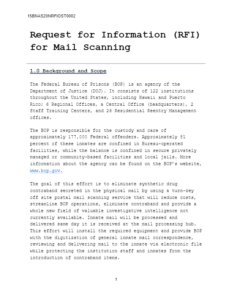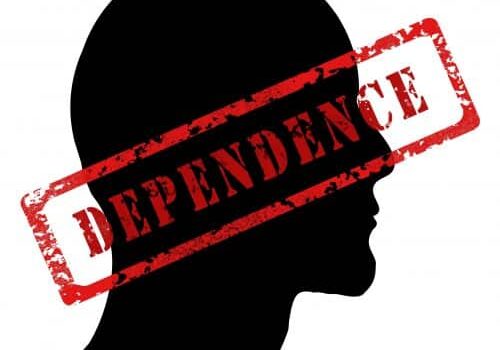BOP Plans To Digitize Incoming Prisoner Mail
The Bureau of Prisons wants to digitize incoming prisoner mail. According to a recent request for information, the Bureau of Prisons hopes “to eliminate synthetic drug contraband secreted in the physical mail by using a turnkey offsite postal mail scanning service that will reduce costs, streamline BOP operations, eliminate contraband and provide a whole new field of valuable investigative intelligence not currently available.”
The request for information further states that “inmate mail will be processed and delivered same day it is received at the  mail processing hub. This effort will install the required equipment and provide BOP with the digitization of general inmate mail correspondence, reviewing and delivering mail to the inmate via electronic file while protecting the institution staff and inmates from the introduction of contraband items.”
mail processing hub. This effort will install the required equipment and provide BOP with the digitization of general inmate mail correspondence, reviewing and delivering mail to the inmate via electronic file while protecting the institution staff and inmates from the introduction of contraband items.”
System Requirements To Digitize Incoming Prisoner Mail
The capabilities and requirements of the proposed system to digitize incoming prisoner mail are extensive. For instance, the system must:
• 3.1 Provide electronic access to scanned inmate mail at no cost to the inmate or the public (indicate how such delivery would occur, e.g. tablet device, kiosk, etc.)Receives, scans and makes mail available at a minimum of 5 days per week excluding federal holidays.
• 3.2 Processes and makes available high definition color scans of inmate mail within 24 hours of it being received by vendor.
• 3.3 Stores hard copies of all mail for a minimum of 45 days.
• 3.4 Provides the public the ability to digitally track their sent mail.
• 3.5 Provides the public the ability to receive rejected mail.
• 3.6 Tracks when it is received, scanned, approved by facility and read by the inmate.
• 3.7 Has the ability to accept or reject all or part of sender’s contents per mailing.
• 3.8 Stamp or tracks each individual document with a unique identifier that is searchable via the database.
• 3.9 Retains a searchable database for each registered sender and all correspondence received.
• 3.10 Allows inmates to zoom in and out of documents to clearly read smaller details.
• 3.11 Provides capability for rotation of documents on scanning and or inmate review display Allows inmates to report issues with specific documents via the platform Allows for the inmate deletion of documents while retaining the document for facility investigations.
• 3.12 Inmate accounts must be secured (e.g. password protected) to prevent unauthorized access by other inmates.
• 3.13 System must have fraud prevention capabilities to prevent unauthorized access by users System must allow for the assignment of unique credentials such that inmates may access mail even if transferred without requiring account reconfiguration. Agency must be able to search for specific parameters without vendor assistance.
• 3.14 Vendor must provide maintenance and support, including after hours (specify support features, communication methods (web, email, phone) and hours provided)
• 3.15 Agency must be able to print mail for an individual inmate.
• 3.16 Facility-wide batch printing available presorted by inmate and by housing location.
• 3.17 Inmate exception reports are auto-generated for inmates that are not able to receive mail.
• 3.18 Inmates must be notified when mail is received and rejected, including standardized messaging explaining reason for rejection,
• 3.19 Capability for mail to be automatically delivered to the inmate without review.
• 3.20 Ability to identify inmates of interest and segregate mail for additional approval by investigative staff before delivery.
• 3.21 Ability to segregate mail with markings or drawings, photographs or other information requiring additional approval while delivering text portion of said document.
• 3.22 Ability to notify investigators of inmates under investigation and track and copy correspondence.
• 3.23 Capability to initiate support request while reviewing the mail.
• 3.24 Capability to place mail in a holding queue without being accepted or rejected while awaiting further review.
• 3.25 If error is detected, mail can be able to be reassigned to another inmate within the same facility or different BOP location.
• 3.26 If mail is approved in error, system allows for mail to be returned to approval que and or deleted.
• 3.27 Vendor must provide and support all hardware and software using screened personnel.
• 3.28 Vendor must supply isolated, separate network.
• 3.29 Vendor must provide separate internet connectivity.
While I am of course concerned about the introduction of drugs into BOP facilities, I do not believe that the plan to digitize incoming prisoner mail is the same thing as giving prisoners hard copies of mail. However, constitutional challenges to allowing only digital mail might prove difficult because the courts are so deferential to prison administrators about such matters. It is further unclear how the BOP will process magazines, catalogs, and other bulky correspondence under this new proposed procedure.
My office will be watching this closely to see what the BOP ultimately decides to do.
Recommended for you
Amendment 782 Motion Reconsideration
Reinaldo Rivera moved for 18 U.S.C. § 3582(c)(2) relief based on Amendment 782 to the Guidelines, commonly known as “drugs minus 2.” The district court granted the motion and reduced his sentence to 420 months from LIFE. But in doing so, the district court believed Rivera’s mandatory minimum was 30 years for his CCE conviction.…
Drug Treatment And Vocational Training Improper Sentencing Considerations
Christopher Thornton moved for a downward variance at sentencing arguing, among other things, that “in-prison treatment during the proposed thirty-eight months would help mitigate any potential risk he posed to the community.” The district court denied the motion, but in doing so said that Thornton had “mental-health issues, and he needs drug treatment” and that…




